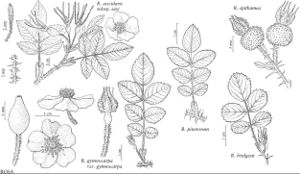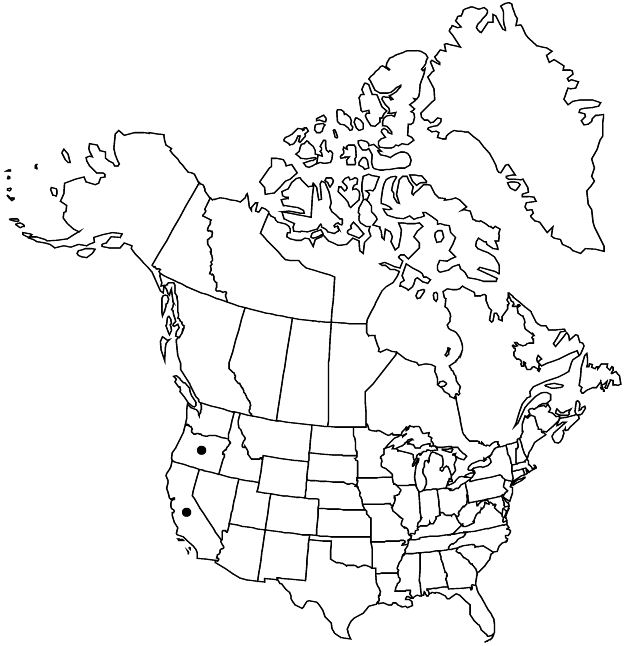Rosa spithamea
in W. H. Brewer et al., Bot. California 2: 444. 1880.
Subshrubs, forming open colonies. Stems erect, 1–5 (–10) dm, openly branched; bark dark reddish-brown, glabrous; infrastipular prickles paired, erect to slightly curved, largest sometimes ± flattened, subulate, 2–8 (–12) × 2–5 mm, base glabrous, internodal prickles absent or sparse to dense, mixed with aciculi, aciculi sometimes absent, stipitate-glandular or eglandular. Leaves 3–10 cm; stipules 6–15 × 1.5–2.5 (–3.5) mm, auricles flared to ± erect, 1.5–6 mm, margins entire, stipitate-glandular, surfaces glabrous, eglandular; petiole and rachis with pricklets, usually glabrous, rarely finely hairy, stipitate-glandular; leaflets 5–7 (–9), terminal: petiolule 3–13 mm, blade ovate-elliptic, sometimes obovate-elliptic, 10–30 × 8–20 mm, membranous to ± leathery, base obtuse, margins ± 2-serrate, teeth 8–20 per side, acute to obtuse, gland-tipped, apex obtuse to ± truncate, abaxial surfaces pale green to green, glabrous, sometimes sparsely hairy, sessile-glandular or eglandular, adaxial green, dull, rarely sparsely hairy. Inflorescences corymbs, 1–10-flowered. Pedicels erect, slender to stout, 2–15 mm, glabrous, rarely finely pubescent, stipitate-glandular, sometimes setose-glandular; bracts 1 or 2, lanceolate, 2–15 × 1.5–5 mm, margins entire, stipitate-glandular, surfaces glabrous, eglandular. Flowers 2.5–3.8 cm diam.; hypanthium ± ovoid, 3–6 × 2.5–5 mm, glabrous, sparsely to densely stipitate to setose-glandular, rarely eglandular, neck 0.5–1 × 2.5–4 mm; sepals spreading, ovatelanceolate, 8–15 × 2.5–3.5 mm, tip 0–4 × 1.3 mm, margins entire, abaxial surfaces glabrous, stipitate-glandular; petals single, deep pink, 12–23 × 15 mm; carpels 15–30, styles exsert 1 mm beyond stylar orifice (2 mm diam.) of hypanthial disc (3.5 mm diam.). Hips scarlet, ± depressed-subglobose, 7–15 × 7–15 mm, fleshy, glabrous, sparsely to densely stipitate to setose-glandular, rarely eglandular, neck 0.5–2 × 2–5 mm; sepals persistent, erect. Achenes basiparietal, 4–17, cream to pale-brown, 3.5–5 × 2.5–3.5 mm. 2n = 14.
Phenology: Flowering May–Aug.
Habitat: Edges and understory of chaparral and mixed forests, post-burn openings
Elevation: 200–2000 m
Discussion
The combination of miniature size and stipitate- to setose-glandular hips makes Rosa spithamea one of the more easily and reliably identified species in the genus, although the density of hypanthial glands can vary. The species occurs from Douglas County, Oregon, to San Luis Obispo County, California. Rosa spithamea is fire-adapted and blooms profusely only after fires or equivalent disturbances; at other times, it persists in the understory in a vegetative state.
E. W. Erlanson (1934) referred to Rosa spithamea as tetraploid (2n = 28); twice in her key to R. spithamea she questioned that count.
Selected References
None.
Lower Taxa
"dm" is not declared as a valid unit of measurement for this property."dm" is not declared as a valid unit of measurement for this property."dm" is not declared as a valid unit of measurement for this property.

